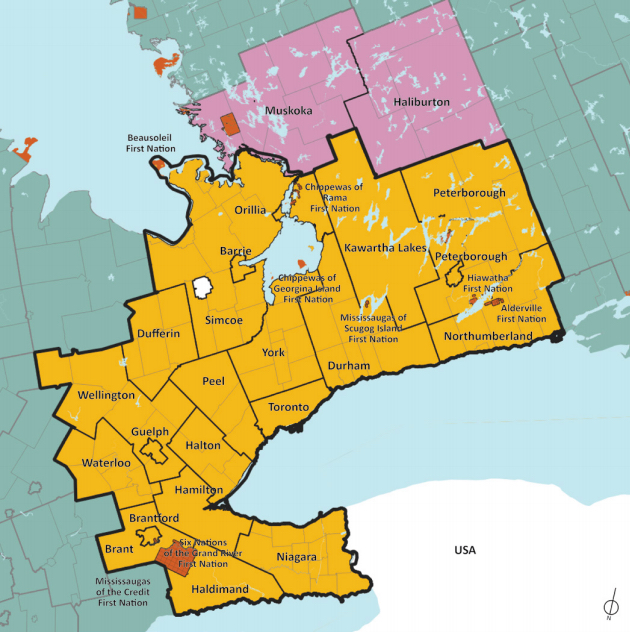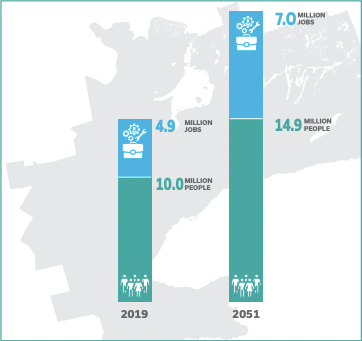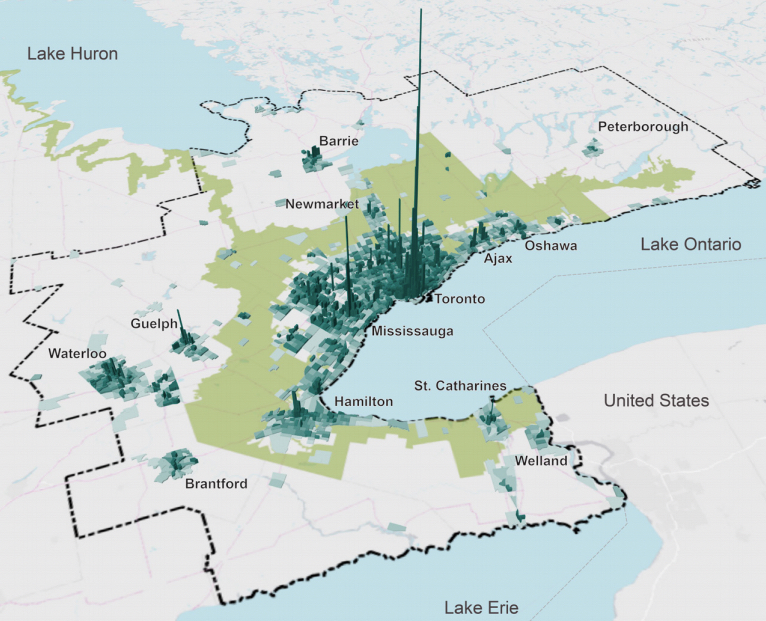The Impact of Ontario’s Transportation Plan on Industrial Real Estate
Forecasting Future Industrial Land, Development, and Property Values
September 24th, 2021
Influence is an interesting concept. Game theorists and advertising experts state that it comes in three major forms: emotional, logical, and repeated messaging (otherwise known as propaganda). In terms of its effectiveness, tapping into emotions is the best way to sell a product or service, while logical arguments about technical features and benefits does very little to sway consumers into action. As examples, Rolex and Lamborghini don’t talk about their products, but rather, they show how owning them makes you feel and appear to the world.
In between these two methods lies the practice of a consistent, repeated message. While not as strong as invoking hope, fear, aspirations, or frustrations, it can cement a narrative quite easily over time.
So, if you have been on our newsletter list for any period of time, then you may have heard me relay a consistent message regarding the GTA Industrial market based on historical data and market activity. It is as follows:
Availabilities are at an all-time low and have pushed up rental rates and valuations to new watermark levels. As a result, developable land has become scarce (and increasingly expensive) as private and institutional investors ‘land bank’ and construct new industrial facilities at a torrid pace. Despite this, we are caught in a supply trap whereby most new inventory is pre-leased, giving little to no relief to Users in need.
However, there are key ongoing initiatives which may change the nature of the industrial market. And we should consider them, lest we become fixated on our current dilemma. These solutions would be grand, sweeping moves which could create a paradigm shift and unlock huge swaths of land for investors and occupiers to take advantage of.
The elegance of this solution lies in its ability to incentivize stakeholders to act quickly to service, zone, and develop this land. When finished, or during the process of completion, we may find an enormous amount of ‘dry powder’ capital deployed rapidly by those eager to do so, but unable to, due to the current industrial landscape.
So what is that solution?
Well, today we’ll examine the province of Ontario’s Greater Golden Horseshoe Transportation Plan, and how the proposed infrastructure projects may unlock thousands of acres that are currently inaccessible by municipalities, developers, and occupiers alike.
The Greater Golden Horseshoe Transportation Plan
According to the Province, “The Greater Golden Horseshoe (GGH) is a large urban region centred around Toronto, encompassing Waterloo, Brant and Haldimand in the west, Niagara to the south, Simcoe in the north, and Peterborough and Northumberland in the east (Figure 1). It is home to 10 million people, or over 60% of Ontario’s population.”

Greater Golden Horseshoe Area. Source: Province of Ontario.
Furthermore, the Province adds – in its Greater Golden Horseshoe Transportation Plan – that “the GGH is the economic engine of the province. Two-thirds of Ontario’s gross domestic product (GDP) is generated here.
“A well-functioning transportation system is critical to economic prosperity. Time waiting for a bus, time stuck in traffic on the way to meet a client or to make a delivery – all of these are costs to our economy. Infrastructure investments haven’t kept up and won’t meet future needs on their own.”
“Over the 15-year period of 2001-2016, travel demand on the highways grew three times faster than the rate of new road construction during this time. This trend will result in more gridlock unless we have a comprehensive and long-term plan. A range of solutions are needed, including increasing infrastructure capacity, using our infrastructure wisely, and providing options for people and businesses to choose the most effective way to get around.”

Greater Golden Horseshoe – People and Jobs. Source: Province of Ontario.

2051 Forecast of Population and Employment Concentration in the GGH. Source: Province of Ontario.
As a whole, the Province intends to bring sweeping change to every aspect of our transportation – from airports and public transit, to ports, rail, and increasing and sustainable access to smaller communities.
What is key for Industrial Investors and Occupiers to track and assess is, not only the 30,000 foot plan, but particular initiatives relating to major highways and arterial roads, as well as commercial lines such as rails, ports, and intermodals.
Near-Term Relief Efforts
This relief to transportation networks will be brought about in the near-term by optimizing existing corridors, creating alternative routes, providing alternative ways to travel, and reducing the need to travel.
For our purposes, we will focus on the expansion of existing networks and the addition of future routes.
Currently, outlined initiatives include the widening of Highway 400, Highway 401, and Highway 9, while implementing bus bypass lanes on Highways 8 and 401. Furthermore, the new Highway 413, also known as the “GTA West Corridor” is scheduled for construction and will connect Highways 400 and 404, which will themselves by extended.
Summarized by the CBC, “the QEW between Burlington and Niagara Falls, Highway 400 between Kettleby and Barrie, Highway 9 between Kettleby and Orangeville, Highway 403 in lower Hamilton as well as between Brantford and the Lincoln Alexander Parkway in Hamilton, Highway 401 between Kitchener and Milton, between Highways 427 and 404 in Toronto and between eastern Pickering and Newcastle, could all see extra lane capacity under the plan.”
Conclusion
Next week, we will look more closely at a few of these initiatives, and further examine their impact on industrial land in relative proximity; including possible increases in supply of new serviceable or developable land, as well as potential effects on land pricing.
Key Takeaways
For investors: Until these projects become reality, one should expect to see land values increase further. Deals are being done as land owners realize the considerable appreciation and value that they may extract through selling. Furthermore, we notice a trend of families in possession of land for decades or generations moving to sell as ownership is passed down. That being said, these opportunities often go off-the-market and are brought to investors by brokers who are diligently tracking parcels and communicating with owners.
For Occupiers: Similarly, one should expect pricing to continue increasing. Opting to purchase and develop land on your own means connecting with an experienced broker to gain access to opportunities as they arise. Alternatively, partnering with a developer may be more expensive or result in an eventual lease – as opposed to long-term ownership – however, it may also be much more reliable, with less risk and better timing on delivery.
Overall, prepare to pay more. Introduce more time into your pursuits of deals. And be prepared to build (two years or more in advance) or complete an early renewal (18 to 24 months out) if you want to stay at your current location.
Finally, for a confidential consultation or a complimentary opinion of value of your property please give us a call.
Until next week…
Goran Brelih and his team have been servicing Investors and Occupiers of Industrial properties in Toronto Central and Toronto North markets for the past 29 years.
Goran Brelih is a Senior Vice President for Cushman & Wakefield ULC in the Greater Toronto Area.
Over the past 29 years, he has been involved in the lease or sale of approximately 25.7 million square feet of industrial space, valued in excess of $1.6 billion dollars while averaging between 40 and 50 transactions per year and achieving the highest level of sales, from the President’s Round Table to Top Ten in GTA and the National Top Ten.
Specialties:
Industrial Real Estate Sales and Leasing, Investment Sales, Design-Build and Land Development
About Cushman & Wakefield ULC.
Cushman & Wakefield (NYSE: CWK) is a leading global real estate services firm that delivers exceptional value for real estate occupiers and owners. Cushman & Wakefield is among the largest real estate services firms with approximately 53,000 employees in 400 offices and 60 countries.
In 2020, the firm had revenue of $7.8 billion across core services of property, facilities and project management, leasing, capital markets, valuation and other services. To learn more, visit www.cushmanwakefield.com.
For more information on GTA Industrial Real Estate Market or to discuss how they can assist you with your real estate needs please contact Goran at 416-756-5456, email at goran.brelih@cushwake.com, or visit www.goranbrelih.com.
Connect with Me Here! – Goran Brelih’s Linkedin Profile: https://ca.linkedin.com/in/goranbrelih
Goran Brelih, SIOR
Senior Vice President, Broker
Cushman & Wakefield ULC, Brokerage.
www.cushmanwakefield.com
www.siorccc.org
Office: 416-756-5456
Mobile: 416-458-4264
Mail: goran.brelih@cushwake.com
Website: www.goranbrelih.com


